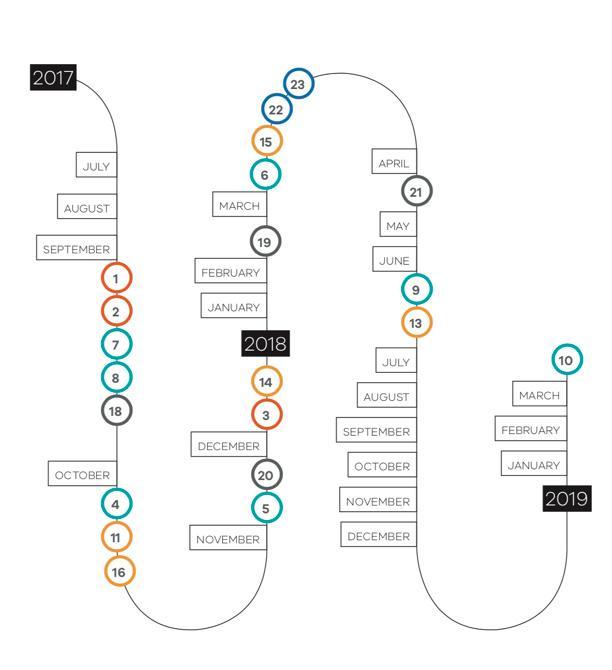30 Excellent Suggestions For Picking A Cybersecurity Company in Dubai
30 Excellent Suggestions For Picking A Cybersecurity Company in Dubai
Blog Article
Top 10 Tips To Evaluate The Variety Of Services Provided By A Cybersecurity Company In Dubai.
1. Determine Core Services OfferedBegin the process by identifying the core services the company offers. Common offerings include risk assessments and incident management, threat management assessment of vulnerability, penetration testing, and security audits. Understanding their core competencies will help you determine if they align with the specific requirements of your business.
2. Review Managed Security Service
Check if the company provides managed security services (MSS). MSS providers offer constant monitoring and management of security systems, which can be crucial for organizations that do not have in-house expertise. By evaluating their capabilities, you will be able to determine their ability provide ongoing assistance.
3. Review Compliance and Regulatory Services
Find out if the cybersecurity business provides services that comply with local and international regulations. This could include help with GDPR and PCI DSS and local laws regarding data privacy. Compliance is essential for companies that operate in highly-regulated industries.
Review Incident Capabilities
Examine how your company responds in the event of an incident. A robust plan for incident response must comprise the detection and control of incidents, elimination and recovery, as well the lessons learned. Understanding their incident response strategy will help them assess the level of preparedness they have for handling cybersecurity-related breaches.
5. Look for Specialized Services
Ask if they offer special services that are suited to certain industries or needs. These could include cloud or IoT security, or even protections that are specific to certain sectors, such as finance or healthcare. The company's specialized services demonstrate its ability to tackle unique issues.
6. Examine the training and awareness programs.
Ask your company whether they provide training and awareness for your employees. Training is essential to minimize human error, which is the primary source of security breaches. Training from top companies will improve your security.
7. Check for Threat Intelligence Services
Check if the firm offers threat intelligence services. These services allow organizations to be informed of new security threats and weaknesses. This lets them adopt proactive measures. Your security strategy can be significantly enhanced by a robust threat intelligence capability.
8. Evaluate Technology Partnerships
Examine the company's relationships with technology providers. Collaborations with the top suppliers of cybersecurity technology can enhance the quality of services and offer access to the most recent tools and solutions. Security measures can be enhanced by the broad tech ecosystem.
9. Assess Customization, Flexibility and Cost
Check if the company can customize services to meet your specific requirements. In the field of cybersecurity, a one-size is not going to be sufficient. Being aware of the flexibility of a company in adjusting their services is essential for managing unique risks.
Review Service Level Agreements
Check the Service Level Agreements associated with the services that are provided. SLAs should clearly describe the types of services offered, their the response time and performance metrics. Understanding these agreements can help establish expectations regarding service delivery. Read the best Cybersecurity Company in Dubai for blog advice including it security jobs, cybersecurity technologist, computer security company, cyber security ot, information security usa, best cybersecurity firms, cybersecurity and technology, cyber security solution, managed security services provider, cyber security security and more.
Top 10 Ways To Evaluate The Incident Response Capabilities Of An It Security Service Company
1. Understand Incident Response FrameworkBegin by looking at the incident response framework the company employs. If the framework is well specified, like in the NIST Cybersecurity Framework, or SANS Incident Response Process for instance, it means that the business is following industry best practices to manage incidents effectively. Make sure they have a well-organized procedure for handling incidents.
2. Evaluate Incident Response Team Expertise
Assess the qualifications in terms of experience, qualifications, and expertise of each member. Look for certifications, such as Certified Incident Handlers and Certified Information Security Professionals. For managing and mitigating an incident efficiently, a knowledgeable team is vital.
Recall past incidents and cases studies
You can request instances or case studies of past incidents managed by the business. Examining how they handle actual situations will give you insight into their efficiency, speed and overall approach to managing incidents. Discover in detail the methods they used to identify, contain or resolved issues.
4. Verify the availability of 24/7 Incident Response Accessibility
Make sure that the company has 24/7 incident response. An incident involving cybersecurity can happen anytime. A staff that is on call 24/7 can help reduce damage while also minimizing recovery time.
5. Contact us about the Incident Detection Tool.
Examine the tools and technology the company utilizes for monitoring and detection of incidents. The most effective detection tools, like Security Information and Event Management Systems (SIEM), and intrusion detection system (IDS) can assist identify potential threats more quickly.
6. Examine Communication Protocols
Find out what the business's communication strategy is with its stakeholders in the course of an event. A clear and efficient communication system is essential for coordinating response to inform stakeholders, as well as making sure everyone is aware of their roles in the event of an incident. Understand how they keep clients updated throughout the process of responding.
7. Review Post Incident Review Processes
Ask about the processes employed by your company for reviewing incidents. Conducting thorough reviews following an incident can help identify lessons learned and areas that need improvement. Businesses that implement changes as a result of the reviews will be more effective.
8. Review Recovery and Remediation Strategies
Know the strategies your company employs to recuperate from a disaster and fix any problems. Effective recovery plans should detail the methods they use to restore systems and data and ensure that any vulnerabilities are fixed to prevent further occurrences. You should inquire about how they can rebuild and strengthen systems following an incident.
Review the Compliance with Regulations
Be sure that your ability to respond to incidents is affixed to the required legal requirements. In some sectors, there may be specific requirements regarding incident reporting and response. These rules are widely known by firms that can guarantee compliance.
10. Find References and Testimonials
Finally, gather references from existing clients who have utilized the company's incident response services. Client testimonials provide insight into a company's effectiveness, reliability overall satisfaction, as well as the level of service provided to incidents. View the top rated application penetration testing dubai for website examples including cyber & network security, cyber security job, information and security, best cyber security company, data security, network and network security, cybersecurity consultancy, network and security, security managed, best cyber security company and more.
Top 10 Suggestions On How To Determine The Security Awareness Of A Company Providing Cyber Services
1. Examine Training ContentStart's evaluation by looking over the contents of the security awareness training programs. Check that the training program addresses important topics like security breaches, such as phishing. social engineering. password security. data protection. and compliance. It is crucial to offer employees an entire curriculum that will aid them in recognizing and responding to threats.
2. Check for Customization Option
Ask if you are able to tailor the training to meet your particular needs and the culture. By tailoring training to specific situations and challenges that employees face, you can increase the effectiveness and efficiency of training and increase retention.
3. Evaluate Training Delivery Techniques
Look into the different methods of learning delivery. The options include online courses, webinars as well as interactive simulations. A mix of different formats is able to accommodate a variety of learning styles and improve the overall efficiency.
4. Interactive Elements
Examine if your course contains interactive elements like quizzes, scenarios, and simulations. Interactive training can boost engagement and learning retention. This makes it easier for employees apply their knowledge to practical situations.
5. Evaluation of Update Frequency
Find out how often training sessions are held and the content is regularly updated. In order to keep your employees updated on the latest cybersecurity risks, you need regular training sessions.
6. Determine the effectiveness of your program
Know how your company assesses the effectiveness of its training programs. Examine metrics like tests conducted prior to and after training along with feedback from the participants and incidents reporting trends. It is crucial to gauge the effectiveness of your training programme. This will help you determine whether it is worth the investment and what improvements could be made.
7. Check for Certification and Compliance
Find out if the program provides the opportunity to earn certifications after completion. Credibility increases for employees when they prove their expertise. Ensure that the training you provide is compatible to any compliance requirements for regulatory compliance that you may be required to meet.
8. Find Testimonials and references
Gather feedback from organizations that have previously utilized the training services. Testimonials provide insight about the effectiveness of the training and how well it was accepted by employees. Positive feedback from clients can be a sign of a solid reputation for providing effective awareness training.
9. Assess Post-Training Assistance
Contact support following training. Ongoing resources, such as periodic refresher courses, newsletters or access to a knowledge base, will help to reinforce the training and ensure that cybersecurity is in the forefront of employees' minds.
10. Evaluation of Engagement and Culture Building
Lastly, evaluate whether the program of training helps in the development of a culture which promotes security in your organization. It is important to look for opportunities to raise awareness, such as newsletters about security, workshops or contests. A well-established security culture will encourage employees to take on responsibility to protect their workplace. See the recommended iconnect for site recommendations including cybersecurity and technology, cyber security consulting company, managed cyber security services, network and security solutions, security it company, learn cyber security, info security, best cyber security company, careers in cyber security, network security tools and more.